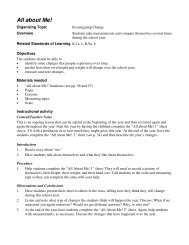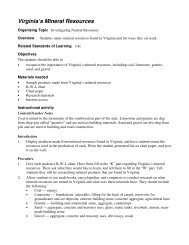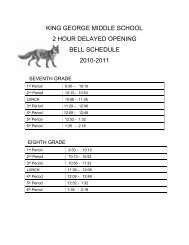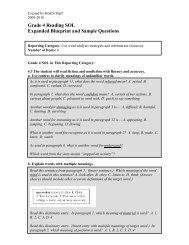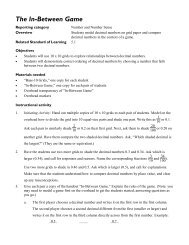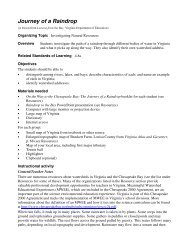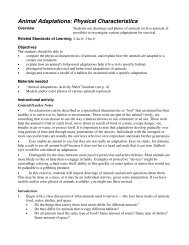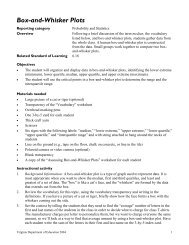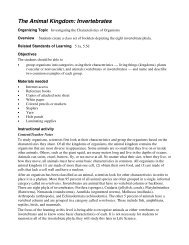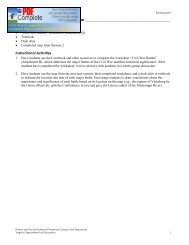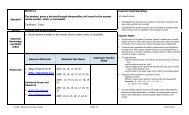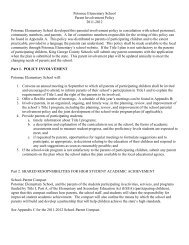Organizing Topic â Investigating the Five Senses
Organizing Topic â Investigating the Five Senses
Organizing Topic â Investigating the Five Senses
You also want an ePaper? Increase the reach of your titles
YUMPU automatically turns print PDFs into web optimized ePapers that Google loves.
The <strong>Five</strong> <strong>Senses</strong>: Smell<br />
<strong>Organizing</strong> <strong>Topic</strong><br />
Overview<br />
Related Standards of Learning K.1a; K.2a, b<br />
Objectives<br />
<strong>Investigating</strong> <strong>the</strong> <strong>Five</strong> <strong>Senses</strong><br />
The students should be able to<br />
• smell an unknown odor and find its match;<br />
• describe unknown smells;<br />
• match <strong>the</strong>ir senses to a corresponding sense organ.<br />
Materials needed<br />
• Popped popcorn in a brown paper bag<br />
• An even number of film canisters — one per student<br />
• Cotton balls — one per film canister<br />
• Extracts — lemon, peppermint, cinnamon<br />
• Spices — onion, ginger, curry, pepper, garlic<br />
• O<strong>the</strong>r pungent odors — cocoa, perfume, baby powder<br />
• Picture cards of things that have good and bad smells<br />
Instructional activity<br />
Students use <strong>the</strong>ir sense of smell to describe and match odors.<br />
Content/Teacher Notes<br />
One of our strongest senses is our sense of smell. We use our nose to smell. Smells can change our<br />
attitude about a place or situation. Smells can make us cringe or even bring back memories. Some<br />
animals use <strong>the</strong>ir sense of smell to locate <strong>the</strong>ir babies.<br />
To prepare <strong>the</strong> canisters, label half of <strong>the</strong>m with letters A through M, and half with numbers 1 through<br />
13. In each lettered canister place <strong>the</strong> cotton ball and a few drops of <strong>the</strong> odor. For each lettered canister,<br />
make a match. When you are finished, you should have a pair of lettered and numbered canisters that<br />
matches by smell. You may want to make a key for your own reference showing <strong>the</strong> matching letters<br />
and numbers.<br />
Safety Note: Teach children to waft — wave <strong>the</strong> smell from a canister. Smelling directly from a canister<br />
can be dangerous; wafting is a safer way to smell odors.<br />
Introduction<br />
1. Teach <strong>the</strong> children <strong>the</strong> song “Eyes, Ears, Nose and Mouth” (to <strong>the</strong> Tune of “Head, Shoulders,<br />
Knees and Toes”):<br />
Eyes, Ears, Nose and Mouth, Nose and Mouth,<br />
Eyes, Ears, Nose and Mouth, Nose and Mouth,<br />
Hands and Fingers make <strong>the</strong> <strong>Five</strong>,<br />
Eyes, Ears, Nose and Mouth, Nose and Mouth!<br />
2. Talk about today’s sense: SMELL. Ask: What do we use to smell?<br />
3. Have students close <strong>the</strong>ir eyes. Open <strong>the</strong> bag of popcorn, and wave it under <strong>the</strong>ir noses. Talk about<br />
what <strong>the</strong>y smell. Ask: What might be in <strong>the</strong> “mystery” bag today?<br />
Procedure<br />
1. Randomly pass out <strong>the</strong> canisters, one to each student. Demonstrate safe smelling — wafting.



